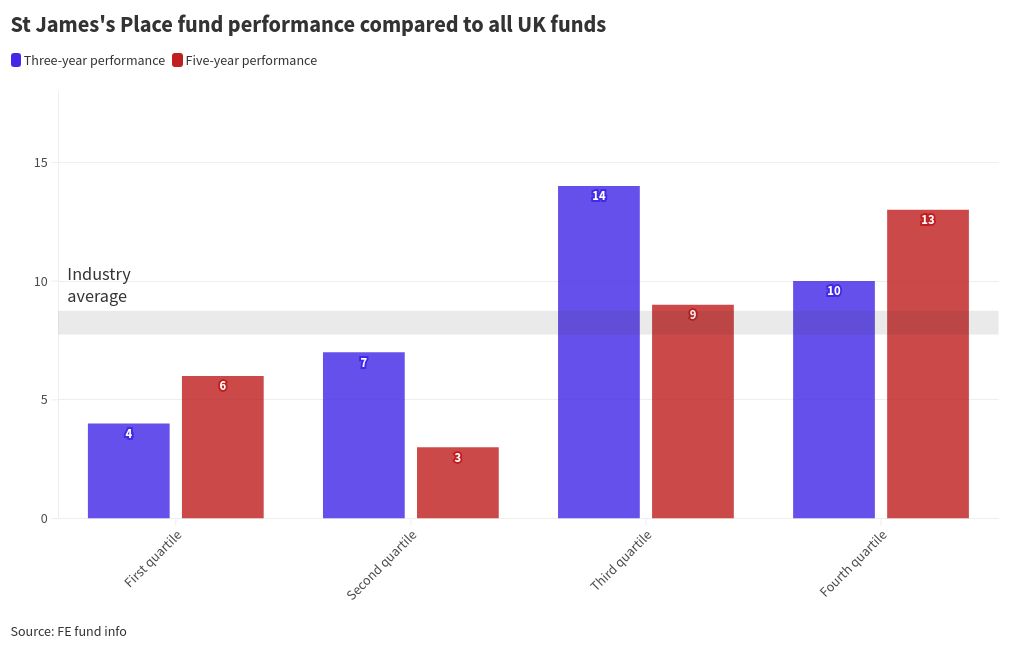Wednesday, August 28, 2024, 6:00 AM
| update:
Tuesday, August 27, 2024 6:59 PM

There’s a problem for investors who want to know how St James’s Place funds are different from other investment vehicles on the market: they can’t.
Traditionally, when comparing funds, you take into account the performance of the assets net of a fund’s fees and compare that to other funds in the same sector.
However, St James’s Place’s fees are expressed as an all-inclusive fee combining advice, product or platform and fund fees.
According to City AM The analysis found that funds from the UK’s largest asset manager performed 6.3% worse than their peers on average over the past five years, and the gap widened to 6.9% when looking at just the group’s equity and multi-asset products.
This means that only six of the asset manager’s 31 funds have been in the top quartile over the past five years, putting them in the top 25% of their peer groups.
In contrast, 13 companies were in the lowest quartile and a further nine in the third quartile.
Earlier this month, St James’s Place faced negative press for running the UK’s largest “dog fund” – a term used to describe funds that have undergone a string of consecutive underperforming deals.
Three of the group’s funds have underperformed, with the largest being the St James’s Place Global Quality fund, with assets under management of 10.7 billion pounds, which has underperformed its benchmark by 27 percent over the past three years, according to Bestinvest data.
But these comparisons don’t work: despite its clearly unstellar performance, the asset manager’s unusual fee structure makes it impossible to accurately assess how St James’s Place stacks up against its rivals.
St James’s Place Pricing
This complex fee structure is a major reason why the company has received slammed in the media over the past year, with analysts criticizing it as “opaque and complicated.”
“The operational and cultural DNA of St James’s Place dates back to the 1980s,” explained Andy Agassangelou, founder of campaign group Transparency Taskforce.
“Of course, the market has changed since then. It is no longer willing to tolerate high, opaque fees and mediocre investment performance, there’s no question about it. High fees eat into bottom-line performance.”
Meanwhile, most other funds on the market only list a management fee and can be purchased by investors on a platform, which charges an additional “platform fee”, or through an advisor, which charges an advisory fee on top of that.
This allows you to track the fund’s performance and compare it with other funds without having to sift through advice or platform fees.
This criticism came to a head last October when the Financial Conduct Authority’s new consumer duty rules and growing customer complaints forced St James’s Place to announce for the first time that it would scrap its controversial exit fee and unbundle other fees.
“The fact that they can’t split the fee goes to the heart of why they announced the fee changes,” one analyst said. City AM
Analysts said the changes, due to be introduced mid-next year, City AM Customers will finally be able to determine whether their investments are actually working out.
However, while the fees are split, they do not necessarily go down.
How expensive is St James’s Place?
Ben Yearsley, director at Fairview Investing, said the “big issue” for asset managers is not necessarily performance but rather fees, which compound just as growth compounds.
Yearsley pointed out that a fund such as St James’s Place Emerging Markets Equity charges a lump sum fee of 1.84%.
“This is about 0.75% higher than most of our peers and represents a roughly 4% underperformance over five years,” Yearsley says. “Surely, an easy way to improve performance would be to just charge the same as the rest of our industry!”
The average fee for the St James’s Place fund is 1.59%, of which 0.5% is an ongoing advice fee for the financial advice provided by SJP’s partners.
Even after subtracting this and taking into account the cost of average platform fees, the prices at St James’s Place are still clearly high.
Earlier this month, City AM It has been revealed that fees for St James’s Place’s Polaris fund, the UK’s largest multi-asset series, are significantly higher than those of its next closest competitor, the Vanguard LifeStrategy series.
“What some might see as the virtues and values of a service-led brand have historically allowed asset managers to ‘defy the laws of gravity’ – much like the myth of the bumblebee: in theory it cannot fly, but in practice it can fly with flying colours,” Agathangelou added.
“But it’s unclear whether this situation will continue forever. True IFAs are good at enticing customers with their best service offerings, so all else being equal, why would a well-informed customer pay more than they need to for what they’re getting?”
A St James’s Place spokesman said it was “not aware of the performance figures presented” but added that its pricing structure would be simplified.
“When looking at performance it’s important to take into account all the fees someone pays in order to make an like-for-like comparison,” the spokesman added. “Under our current fee structure, the performance of SJP funds includes a single ongoing fee which covers the costs of external fund managers, administration and advice.”
“Unbundling” the rates in 2025 “will simplify comparisons with peers,” they said.
“Most of our clients allocate capital to a diversified portfolio of investment strategies,” they added. “In our view, that is the best way to meet client outcomes and deliver risk-adjusted returns over the medium to long term.”
#Jamess #Place #High #fees #hide #asset #managers #true #performance
